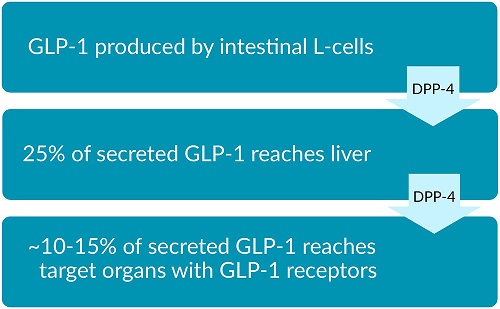Choosing the Relevant GLP-1 Species to Study
A better understanding of incretins has led to tremendous therapeutic advances in the field of type 2 diabetes1. These hormones are released from the gut in response to food ingestion and lead to the stimulation of pancreatic β-cells which then release insulin in a glucose-concentration dependent manner1. One such hormone is glucagon-like peptide-1 (GLP-1) that has been shown to initiate glucose-stimulated insulin secretion2. However, GLP-1 is easily degraded by the time it reaches circulation1. Have you wondered if you are choosing the relevant GLP-1 species for your study? The lifecycle of GLP-1 regulates its metabolic effects as it makes its way into circulation and this is a key component in determining the type of GLP-1 form you want to measure.
The GLP-1 Lifecycle
When food is ingested, GLP-1 is secreted from intestinal endocrine L-cells in a biphasic pattern, starting with an early phase (within 10-15 minutes) followed by a longer secondary phase (30-60 minutes after ingestion)2. Once released from the L-cells, GLP-1 acts within the hepato-portal circulation to activate GLP-1 receptors located on vagal sensory neurons3. GLP-1 makes its way from the liver to peripheral tissues within the pancreas, brain, gastrointestinal tract, lung, and heart; all of which are known to also express GLP-1 receptors1. As GLP-1 travels from the gastrointestinal tract to various organs, it is subject to degradation by dipeptidyl peptidase 4 (DPP-4)1. Only 25% of the originally secreted hormone, active GLP-1, makes its way to the liver. Further degradation occurs as the hormone continues on to peripheral organs. Ultimately, only 10-15% of the originally secreted active GLP-1 reaches peripheral organs1. The highest levels of released active GLP-1 are found immediately within the hepato-portal circulation due to the rapid degradation by DPP-43. Understanding this lifecycle is important for determining if you quantitate the relevant GLP-1 species for your study.

Choosing the Relevant GLP-1 Species to Study
Should you be measuring total GLP-1 levels that include the various metabolites of what was originally secreted from the L-cells? Or should you measure active GLP-1 which is considered to be the biologically active form of GLP-1? While the biologically active form may be more relevant, as that is what acts directly on the pancreas to stimulate insulin secretion, some believe it may be important to study the indirect and neurally-mediated action of all forms of GLP-1 which potentiate glucose-stimulated insulin secretion (GSIS)3. Measuring total GLP-1 would not only provide information about the secretion of GLP-1, but also about the biological effects via both endocrine and non-endocrine routes. In theory, this would provide researchers with a more comprehensive picture of the remaining effects of GLP-1 on insulin secretion3. On the other hand, there are others that may be studying the effects and mechanisms of different DDP-4 inhibitors. This would require them to measure active GLP-1 levels to truly understand the metabolism of the various GLP-1 species3. It becomes apparent then that choosing the relevant GLP-1 species for your study is entirely dependent on the goal of your study.
Conclusion
GLP-1 is an extremely labile hormone since it becomes heavily degraded by DPP-4 as it circulates through the body. Various metabolites resulting from this degradation have different effects on the body, specifically when it comes to ensuring glucose homeostasis. Choosing the relevant GLP-1 species to investigate is entirely dependent on your study. And so, as research continues to elucidate the mechanistic actions of different GLP-1 metabolites, it is important to continuously examine whether you are using the right tools and methodologies in order for you to advance your research study.
References
- Tian & Jin. (2016). The incretin hormone GLP-1 and mechanisms underlying its secretion. J Diabetes, 8(6), 753-765. doi: 10.1111/1753-0407.12439.
- Nadkarni et al. (2014). Regulation of glucose homeostasis by GLP-1. Prog. Mol. Biol. Transl. Sci., 121, 23-65. doi: 10.1016/B978-0-12-800101-1.00002-8.
- Kuhre et al. (2015). Measurement of the incretin hormones: Glucagon-like peptide-1 and glucose-dependent insulinotropic peptide. J. Diabetes Complications, 29(3), 445-450. doi: 10.1016/j.jdiacomp.2014.12.006.

